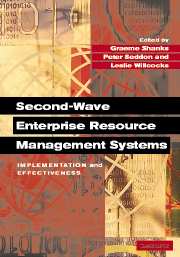Book contents
- Frontmatter
- Contents
- List of Contributors
- Introduction: ERP – The Quiet Revolution?
- Part I Implementation and Effectiveness: Overview
- 1 Learning from Adopters' Experiences with ERP: Problems Encountered and Success Achieved
- 2 Innovating with Packaged Business Software: Towards an Assessment
- 3 A Comprehensive Framework for Assessing and Managing the Benefits of Enterprise Systems: The Business Manager's Perspective
- 4 The Continuing ERP Revolution: Sustainable Lessons, New Modes of Delivery
- Part II From Risks to Critical Success Factors
- Part III From Learning to Knowledge
- Part IV Cultural Aspects of Enterprise Systems
- Part V Future Directions
- Index
- References
1 - Learning from Adopters' Experiences with ERP: Problems Encountered and Success Achieved
from Part I - Implementation and Effectiveness: Overview
Published online by Cambridge University Press: 05 February 2012
- Frontmatter
- Contents
- List of Contributors
- Introduction: ERP – The Quiet Revolution?
- Part I Implementation and Effectiveness: Overview
- 1 Learning from Adopters' Experiences with ERP: Problems Encountered and Success Achieved
- 2 Innovating with Packaged Business Software: Towards an Assessment
- 3 A Comprehensive Framework for Assessing and Managing the Benefits of Enterprise Systems: The Business Manager's Perspective
- 4 The Continuing ERP Revolution: Sustainable Lessons, New Modes of Delivery
- Part II From Risks to Critical Success Factors
- Part III From Learning to Knowledge
- Part IV Cultural Aspects of Enterprise Systems
- Part V Future Directions
- Index
- References
Summary
Introduction
One of the most enduring research topics in the field of information systems is that of systems success (Ballantine et al., 1996; DeLone and McLean, 1992; Lyytinen and Hirschheim, 1987). Prior research has addressed the measurement of success, the antecedents of success, and the explanations of success or failure. Yet, with each new type of information technology or application, the question of success comes up again. In the case of enterprise resource planning (ERP) systems, success takes on a special urgency since the costs and risks of these massive technology investments rival their potential payoffs. Failures of ERP system implementation projects have been known to lead to organizational bankruptcy (Bulkeley, 1996; Davenport, 1998; Markus and Tanis, 2000).
Briefly, ERP are commercial software packages that enable the integration of transactions-oriented data and business processes throughout an organization. From a base in manufacturing and financial systems, ERP systems may eventually allow for integration of inter-organizational supply chains (Davenport, 1998; Markus and Tanis, 2000). Because these systems touch so many aspects of a company's internal and external operations, their successful deployment and use are critical to organizational performance and survival.
- Type
- Chapter
- Information
- Second-Wave Enterprise Resource Planning SystemsImplementing for Effectiveness, pp. 23 - 55Publisher: Cambridge University PressPrint publication year: 2003
References
- 10
- Cited by

